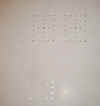 |
 |
First Things First
Before the first hole is drilled in the aircraft, the approval for those holes must first be obtained. Anytime you drill a hole in a pressurized area of an aircraft, you'll need FAA approval. The standard procedure is to hire a structures DER (Designated Engineering Rep) to determine what size double plates are needed, rivet and screw sizes. The DER then sends the shop the prints as to where to drill and how to properly install the antennas in this case. Now the installer takes the prints supplied by the DER and installs the antennas per his/her instructions. Before the aircraft is returned to service, a 337 form is went to the local FAA approval for the antenna installation. The local feds see there is a DER report for the installation and normally approve the installation. Without the DER report, chances are you'll never legally return the aircraft to service. Actually we had the DER reports in hand prior to delivery of the aircraft so we could jump on the antenna installation early. Preparation is the name of the game in avionics.
Note in the pic below all the holes that are required to install the doubler place for the SkyWatch antenna. The metal still needs prepped but the goal here was to scare the heck out of you with all of those holes in the pressurized vessel!
Unlike many general aviation aircraft, the King Air 200 is well-built and designed. Notice the avionics junction box in the nose area. This junction box allows easy access to the audio, VOR and just about any other piece of avionics in the aircraft that we may need to tie into.